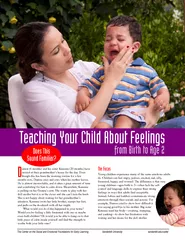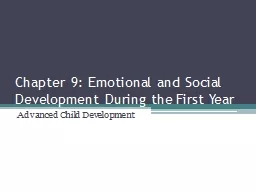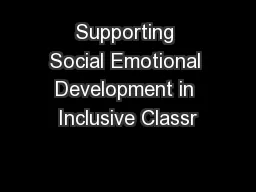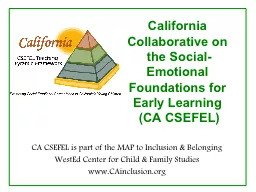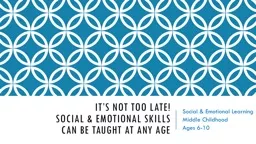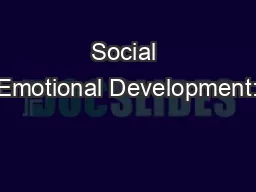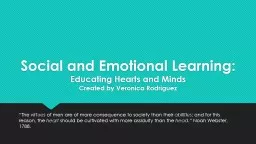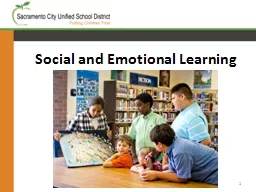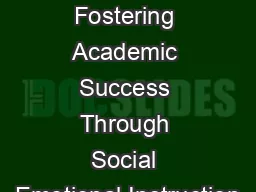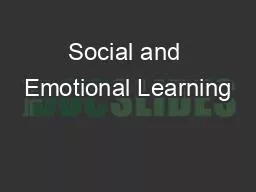PDF-The Center on the Social and Emotional Foundations for
Author : lois-ondreau | Published Date : 2015-04-21
educsefel amon 6 months and his sister Karenna 20 months have arrived at their grandmothers house for the day Even though this has been the morning routine for a
Presentation Embed Code
Download Presentation
Download Presentation The PPT/PDF document "The Center on the Social and Emotional F..." is the property of its rightful owner. Permission is granted to download and print the materials on this website for personal, non-commercial use only, and to display it on your personal computer provided you do not modify the materials and that you retain all copyright notices contained in the materials. By downloading content from our website, you accept the terms of this agreement.
The Center on the Social and Emotional Foundations for: Transcript
educsefel amon 6 months and his sister Karenna 20 months have arrived at their grandmothers house for the day Even though this has been the morning routine for a few months now Damon cries and cries when his mother leaves He is almost inconsolable an. Learning (SEL): Teachers’ Matter. Kimberly A. . Schonert-Reichl. , . Ph. .D.. University of British Columbia. Learning Forward and DLC. May 17, 2012. In referring to important characteristics in school culture . . . . Advanced Child Development . The Terms: Create a Foldable. Emotional Development. Pacifier . Social Development. Aggressive . Attachment . Consistency . Failure to thrive . Personality. Placid. Self-concept. Gail E. Joseph, Ph.D.. Educational Psychology. University of Washington. Today. Identify the teachable moments in preventing challenging behavior supporting social emotional competence. Framework for supporting young children’s social emotional competence. CA CSEFEL is part of the MAP to Inclusion & Belonging. WestEd Center for Child & Family Studies. www.CAinclusion.org. National CSEFEL. It began at the national level with the Center on the Social Emotional Foundations for Early Learning. CAN BE TAUGHT at any age. Social & Emotional Learning . Middle Childhood . Ages 6-10. WHAT IS SOCIAL & EMOTIONAL LEARNING? . Social . learning . comprises . the principles and strategies . (i.e. perspective-taking, empathy. Nurturing Brain, Mind, Child, and Relationship for Lifelong Health. Sherri L. Alderman, MD, MPH, IMH-E, FAAP. Developmental Behavioral Pediatrician. OCCYSHN Coffee Time Consultations . December 10, 2013 . Educating Hearts and Minds . Created by Veronica Rodriguez. “The . virtues. of men are of more consequence to society than their . abilities. ; and for this reason, the . heart. should be cultivated with more assiduity than the. 1. 2. Questions For Our Session. What is Social and Emotional Learning (SEL)? . How does SEL promote success in school and life?. What is SCUSD's plan for the next three years?. What will SEL integration look like at the district, school, and classroom levels?. Nicole Moyer, EdS, NCSP. Pine Springs Preparatory Academy. What is Social Emotional Learning? . “Social and emotional learning (SEL) teaches children to recognize and understand their emotions, feel empathy, make decisions, and build and maintain relationships.”. La gamme de thé MORPHEE vise toute générations recherchant le sommeil paisible tant désiré et non procuré par tout types de médicaments. Essentiellement composé de feuille de morphine, ce thé vous assurera d’un rétablissement digne d’un voyage sur . . SYFTET. Göteborgs universitet ska skapa en modern, lättanvänd och . effektiv webbmiljö med fokus på användarnas förväntningar.. 1. ETT UNIVERSITET – EN GEMENSAM WEBB. Innehåll som är intressant för de prioriterade målgrupperna samlas på ett ställe till exempel:. 1andTraditionally Underserved PopulationsPolicy BriefLogan Nicole BeyerAmerican Youth Policy ForumwwwaypforgAYPFTweetsSocial and Emotional Learning and Traditionally Underserved Populations2Social Emo Get complete detail on 1Z0-811 exam guide to crack Oracle Java Foundations. You can collect all information on 1Z0-811 tutorial, practice test, books, study material, exam questions, and syllabus. Firm your knowledge on Oracle Java Foundations and get ready to crack 1Z0-811 certification. Explore all information on 1Z0-811 exam with number of questions, passing percentage and time duration to complete test. Experience the best eye care center in Pune. The best clinics for your eye health, include the prestigious Dr. Sonalika Eye Clinic. At Hadapsar, Amanora, Magarpatta, Mundhwa, Kharadi Rd, Viman Nagar, Wagholi, and Wadgaon Sheri
Download Document
Here is the link to download the presentation.
"The Center on the Social and Emotional Foundations for"The content belongs to its owner. You may download and print it for personal use, without modification, and keep all copyright notices. By downloading, you agree to these terms.
Related Documents

